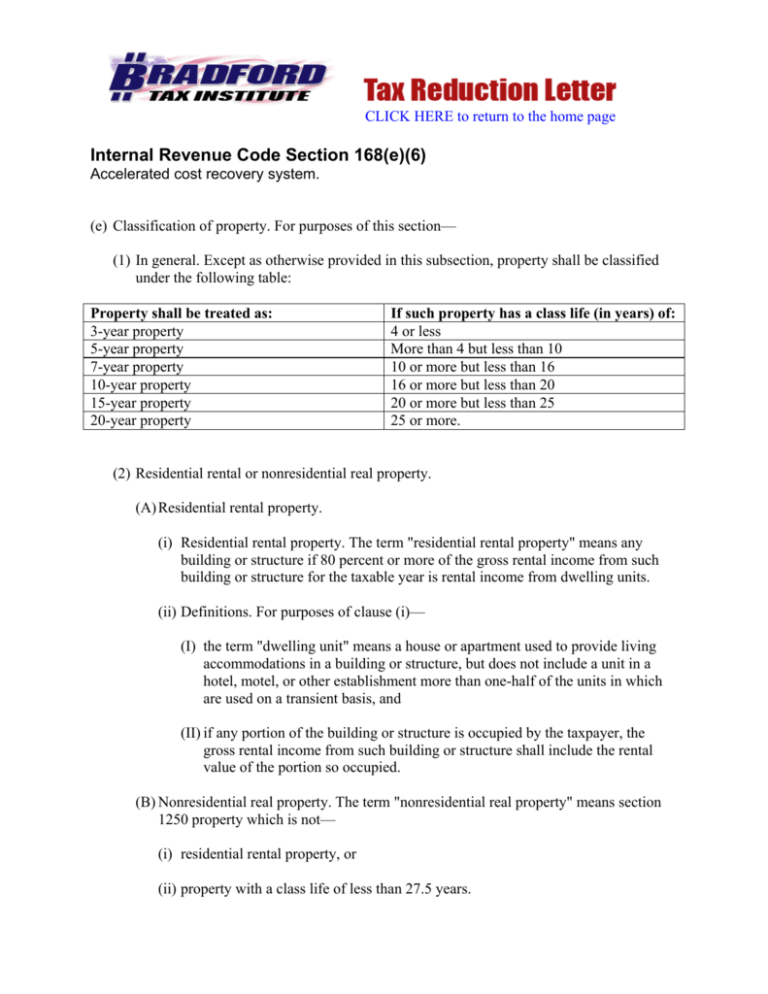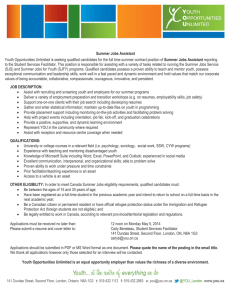Internal Revenue Code Section 168(e)(6)
advertisement

CLICK HERE to return to the home page Internal Revenue Code Section 168(e)(6) Accelerated cost recovery system. (e) Classification of property. For purposes of this section— (1) In general. Except as otherwise provided in this subsection, property shall be classified under the following table: Property shall be treated as: 3-year property 5-year property 7-year property 10-year property 15-year property 20-year property If such property has a class life (in years) of: 4 or less More than 4 but less than 10 10 or more but less than 16 16 or more but less than 20 20 or more but less than 25 25 or more. (2) Residential rental or nonresidential real property. (A) Residential rental property. (i) Residential rental property. The term "residential rental property" means any building or structure if 80 percent or more of the gross rental income from such building or structure for the taxable year is rental income from dwelling units. (ii) Definitions. For purposes of clause (i)— (I) the term "dwelling unit" means a house or apartment used to provide living accommodations in a building or structure, but does not include a unit in a hotel, motel, or other establishment more than one-half of the units in which are used on a transient basis, and (II) if any portion of the building or structure is occupied by the taxpayer, the gross rental income from such building or structure shall include the rental value of the portion so occupied. (B) Nonresidential real property. The term "nonresidential real property" means section 1250 property which is not— (i) residential rental property, or (ii) property with a class life of less than 27.5 years. (3) Classification of certain property. (A) 3-year property. The term "3-year property" includes— (i) any race horse— (I) which is placed in service before January 1, 2014, and (II) which is placed in service after December 31, 2013, and which is more than 2 years old at the time such horse is placed in service by such purchaser, (ii) any horse other than a race horse which is more than 12 years old at the time it is placed in service, and (iii)any qualified rent-to-own property. (B) 5-year property. The term "5-year property" includes— (i) any automobile or light general purpose truck, (ii) any semi-conductor manufacturing equipment, (iii)any computer-based telephone central office switching equipment, (iv) any qualified technological equipment, (v) any section 1245 property used in connection with research and experimentation, (vi) any property which— (I) is described in subparagraph (A) of section 48(a)(3) (or would be so described if "solar or wind energy" were substituted for "solar energy" in clause (i) thereof and the last sentence of such section did not apply to such subparagraph), (II) is described in paragraph (15) of section 48(l) (as in effect on the day before the date of the enactment of the Revenue Reconciliation Act of 1990) and is a qualifying small power production facility within the meaning of section 3(17)(C) of the Federal Power Act (16 U.S.C. 796(17)(C)), as in effect on September 1, 1986, or (III) is described in section 48(l)(3)(A)(ix) (as in effect on the day before the date of the enactment of the Revenue Reconciliation Act of 1990), and (vii) any machinery or equipment (other than any grain bin, cotton ginning asset, fence, or other land improvement) which is used in a farming business (as defined in section 263A(e)(4)), the original use of which commences with the taxpayer after December 31, 2008, and which is placed in service before January 1, 2010. Nothing in any provision of law shall be construed to treat property as not being described in clause (vi)(I) (or the corresponding provisions of prior law) by reason of being public utility property (within the meaning of section 48(a)(3)). (C) 7-year property. The term "7-year property" includes— (i) any railroad track and (ii) any motorsports entertainment complex, (iii)any Alaska natural gas pipeline, (iv) any natural gas gathering line the original use of which commences with the taxpayer after April 11, 2005, and (v) any property which— (I) does not have a class life, and (II) is not otherwise classified under paragraph (2) or this paragraph. (D) 10-year property. The term "10-year property" includes— (i) any single purpose agricultural or horticultural structure (within the meaning of subsection (i)(13)), (ii) any tree or vine bearing fruit or nuts, (iii)any qualified smart electric meter, and (iv) any qualified smart electric grid system. (E) 15-year property. The term "15-year property" includes— (i) any municipal wastewater treatment plant, (ii) any telephone distribution plant and comparable equipment used for 2-way exchange of voice and data communications, (iii)any section 1250 property which is a retail motor fuels outlet (whether or not food or other convenience items are sold at the outlet), (iv) any qualified leasehold improvement property placed in service before January 1, 2010, (v) any qualified restaurant property placed in service before January 1, 2010, (vi) initial clearing and grading land improvements with respect to gas utility property, (vii) any section 1245 property (as defined in section 1245(a)(3)) used in the transmission at 69 or more kilovolts of electricity for sale and the original use of which commences with the taxpayer after April 11, 2005, (viii) any natural gas distribution line the original use of which commences with the taxpayer after April 11, 2005, and which is placed in service before January 1, 2011, and (ix) any qualified retail improvement property placed in service after December 31, 2008, and before January 1, 2010. (F) 20-year property. The term "20-year property" means initial clearing and grading land improvements with respect to any electric utility transmission and distribution plant. (4) Railroad grading or tunnel bore. The term "railroad grading or tunnel bore" means all improvements resulting from excavations (including tunneling), construction of embankments, clearings, diversions of roads and streams, sodding of slopes, and from similar work necessary to provide, construct, reconstruct, alter, protect, improve, replace, or restore a roadbed or right-of-way for railroad track. (5) Water utility property. The term "water utility property" means property— (A) which is an integral part of the gathering, treatment, or commercial distribution of water, and which, without regard to this paragraph, would be 20-year property, and (B) any municipal sewer. (6) Qualified leasehold improvement property. The term "qualified leasehold improvement property" has the meaning given such term in section 168(k)(3) except that the following special rules shall apply: (A) Improvements made by lessor. In the case of an improvement made by the person who was the lessor of such improvement when such improvement was placed in service, such improvement shall be qualified leasehold improvement property (if at all) only so long as such improvement is held by such person. (B) Exception for changes in form of business. Property shall not cease to be qualified leasehold improvement property under subparagraph (A) by reason of— (i) death, (ii) a transaction to which section 381(a) applies, (iii)a mere change in the form of conducting the trade or business so long as the property is retained in such trade or business as qualified leasehold improvement property and the taxpayer retains a substantial interest in such trade or business, (iv) the acquisition of such property in an exchange described in section 1031, 1033, or 1038 to the extent that the basis of such property includes an amount representing the adjusted basis of other property owned by the taxpayer or a related person, or (v) the acquisition of such property by the taxpayer in a transaction described in section 332, 351, 361, 721, or 731 (or the acquisition of such property by the taxpayer from the transferee or acquiring corporation in a transaction described in such section), to the extent that the basis of the property in the hands of the taxpayer is determined by reference to its basis in the hands of the transferor or distributor. (7) Qualified restaurant property. (A) In general. The term "qualified restaurant property" means any section 1250 property which is— (i) a building, if such building is placed in service after December 31, 2008, and before January 1, 2010, or (ii) an improvement to a building, if more than 50 percent of the building's square footage is devoted to preparation of, and seating for on-premises consumption of, prepared meals. (B) Exclusion from bonus depreciation. Property described in this paragraph shall not be considered qualified property for purposes of subsection (k). (8) Qualified retail improvement property. (A) In general. The term "qualified retail improvement property" means any improvement to an interior portion of a building which is nonresidential real property if— (i) such portion is open to the general public and is used in the retail trade or business of selling tangible personal property to the general public, and (ii) such improvement is placed in service more than 3 years after the date the building was first placed in service. (B) Improvements made by owner. In the case of an improvement made by the owner of such improvement, such improvement shall be qualified retail improvement property (if at all) only so long as such improvement is held by such owner. Rules similar to the rules under paragraph (6)(B) shall apply for purposes of the preceding sentence. (C) Certain improvements not included. Such term shall not include any improvement for which the expenditure is attributable to— (i) the enlargement of the building, (ii) any elevator or escalator, (iii)any structural component benefitting a common area, or (iv) the internal structural framework of the building. (D) Exclusion from bonus depreciation. Property described in this paragraph shall not be considered qualified property for purposes of subsection (k). (E) Termination. Such term shall not include any improvement placed in service after December 31, 2009.





